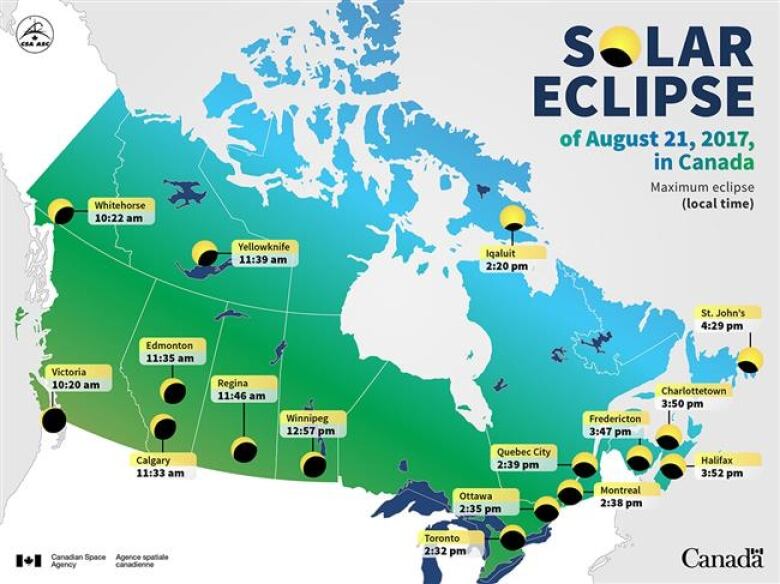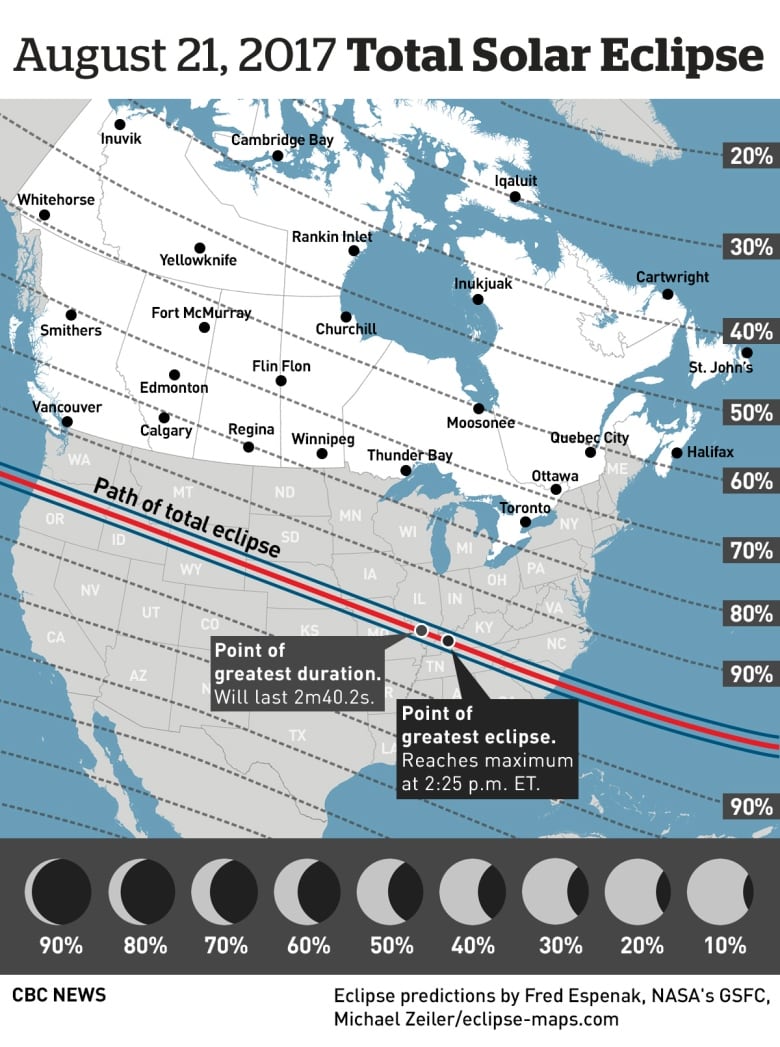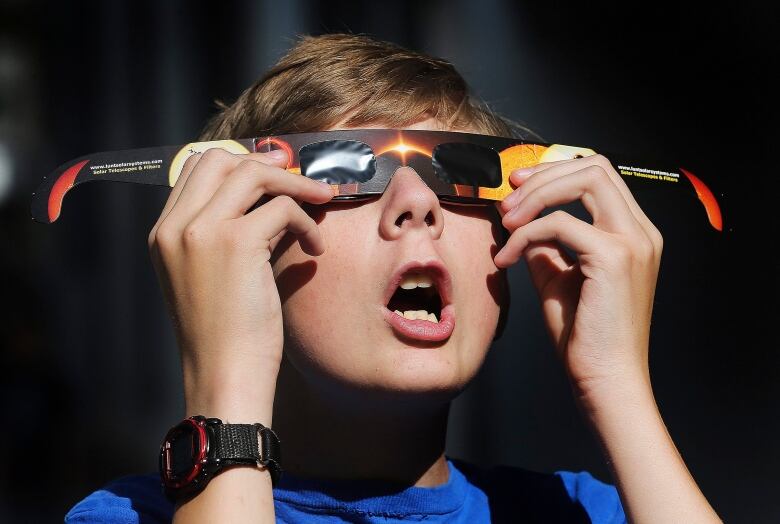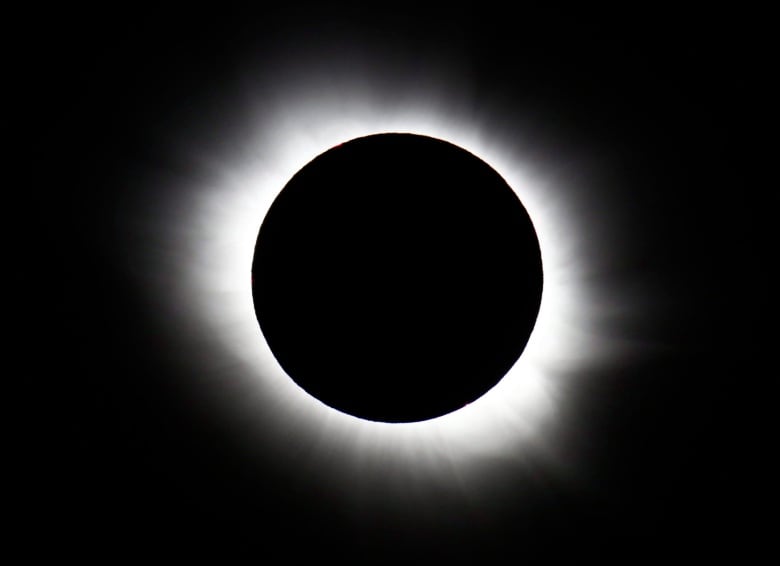Millions prepare to watch rare total solar eclipse
Continental U.S. has not seen a total solar eclipse since 1918

For a few moments today, millions will experience a rare total eclipse across the continental U.S. and millions more in Canada will get a chance to take in a partial eclipse.
CBC News will broadcast a live special, hosted by Hannah Thibedeau, starting at1 p.m. ET. Watch it on CBC News Network or live streamed on CBCNews.ca. CBCNews.ca will also bring you on-the-ground coverage from sites across North Americavia our live blog, kicking off at11 a.m. ET. You can also follow along onFacebookandYouTube.
The path of totality or the regions thatwill get a complete eclipse will pass over Oregon, continuing through the U.S. heartland all the way to Charleston, S.C. Those on the outskirts well into Canada, Central America and even the top of South America will be treated to a partial eclipse.
- Total solar eclipse 2017: ReadCBC'scomplete coverage
- INTERACTIVE | What you need to know about today's eclipse
The time at which the total or partial eclipse will be seen varies with location. Canadians watching from Victoria will see about a 90 per cent eclipse around 10:20 PT, while Torontonianswill see about a 72 per cent eclipse at 2:30 ET. You can use our interactive tool to learn the best time to watch in your area.

Though partial eclipses occur every year, total eclipses are rare and the U.S. hasn't seen once sweep across the width of its country since 1918.
Here's what else you need to know:
What's a total solar eclipse?
When the moon passes between Earth and the sun, and scores a bull's-eye by completely blotting out the sunlight, that's a total solar eclipse. The moon casts a shadow on our planet. Dead centre is where sky gazers get the full treatment. In this case, the total eclipse will last up to twominutes and 40-plus seconds in places.
A partial eclipse will be visible along the periphery. Clouds could always spoil the view, so eclipse watchers need to be ready to split for somewhere with clear skies, if necessary.
What's the eclipse path?
The path of totality will begin near Lincoln City, Ore., as the lunar shadow makes its way into the U.S. This path will be 97 to 113 kilometres; the closer to the centre, the longer the darkness.

Totality will cross from Oregon into Idaho, Wyoming, Nebraska, Kansas, Missouri, Illinois, Kentucky, Tennessee, Georgia, North Carolina and, finally, South Carolina. It will also pass over tiny slivers of Montana and Iowa. The eclipse will last longest near Carbondale, Ill.: about two minutes and 40seconds.
The biggest cities in the path include Nashville; Columbia and Charleston, S.C.; Salem, Ore.; Casper, Wyo.; and just partially within, St. Louis and Kansas City, Mo.
Though there won't be a total eclipse in Canada, B.C. will experience the most extensive partial coverage in the countrywith Victoria seeing a 90 per cent eclipse and Vancouver seeing 86 per cent.

Protect your eyes
Looking directly into the sun is dangerous, and doing so during an eclipse is no different.
To protect your eyes, wear special eclipse glasses not everyday sunglasses that block 99.9999 per cent of sunlight.
- Demand for eclipse glasses outpaces supply
- Technology allows visually impaired, blind to experience solar eclipse
You can get them at many local museums and science centres, or order through websites like the Royal Astronomical Society of Canada. Just make sure they aren't fake.
When's the next one?
If you miss Monday's eclipse, you'll have to wait seven years to see another one in the continental U.S. The very next total solar eclipse will be in 2019, but you'll have to be below the equator for a glimpse. We're talking the South Pacific, and Chile and Argentina. It's pretty much the same in 2020.

For the U.S. and Canada, the next total solar eclipse will occur on April 8, 2024. New BrunswickandNewfoundlandwill boast the best eclipse views in Canada. Those in Labrador, as well as other parts of Atlantic Canada, will be treated to a partial eclipse.
The line of totality will cross from Texas, up through the Midwest, almost directly over Indianapolis, Cleveland and Buffalo, New York, up over New England and out over Maine, New Brunswick and Newfoundland.
Ever wonder what a solar eclipse would look like from space? Take a look at this one captured by @nasa! pic.twitter.com/YYnl0NW09Z
—@NWSSpokaneWith files from The Associated Press













_(720p).jpg)


 OFFICIAL HD MUSIC VIDEO.jpg)
.jpg)



























































































